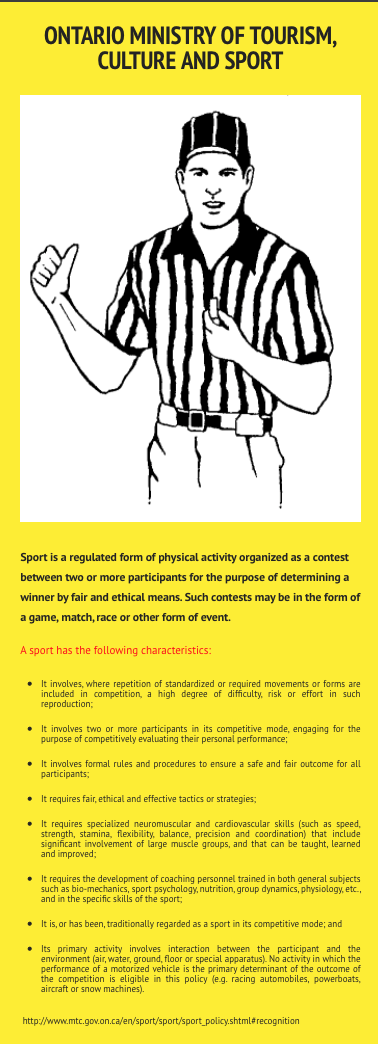BY SHAUN FITL
Sport is a fluid, dynamic phenomenon. One moment is spent in defensive gear and in a split second the gear changes and the team shifts to their attack. A team member who excels in playmaking can often find themselves engaging in solo goal attempts.
From this acknowledgement of changeability, it is very difficult to confine the elements of a sporting event to objective criteria. This description and essential nature applies equally to the game in motion and the game on paper.
It is understood that to find the true core of what defines sport as a professional activity the search will have to address key elements of a single game. Physicality, population, organization and entertainment.
These general guidelines will be used to answer the question of whether or not gaming or paintball is a sport, and why fencing and karate is, according to Sport Canada.
The official Sport Canada definition available through the Ministry of Tourism, Culture and Sport is a tad too regimented and specific to overarch all activities and to properly organize them by criteria. Its usefulness is more bureaucratic than insightful.
“Are you keeping score?”
Ken Babcock, director of athletics and recreation at Durham College, gives a simplified, single inquiry definition that, while sharp and accurate, can be easily overlooked.
Still, Babcock touches on other criteria such as institutional structure, funding and popularity.
A sport has a league, which would include costs, revenues and the fans.
He suggests that “[in sport] there is a skill ability applied to it [but] you have to think outside of the box.”
Shawn Klein, a professor at Arizona State University and editor of the Defining Sport anthology, says “competitive activity is one key element [of sport], the other is physicality – the superior player of the game will have a superior set of the skills that are relevant.”
He widens the discussion, philosophically, by commenting, “‘what counts as being physical?’ does [for example] the fine motor skills required to use a controller count as physical or not?”
Professional video-gaming has leagues with a solid revenue and fan base, but falls short on the physicality element. How important is one criteria than the other?
For this reason, Klein implies that the traditional criteria are a bit nuanced and not so straightforward.
Many people may assume publicized competitions denote sporting, however, OCAA executive director Doug Gellatly explains that just because an activity is shown on a sports television channel does not make it a sport.
Although Gellatly points to factors such as agility, hand-eye coordination, fitness, strength, cardiovascular level, flexibility, etc., he also clarifies that “a huge part of sport that sometimes gets overlooked is how it contributes to the development of the person [athlete].”
Sport, in a sense, also integrates factors such as social skills, respect, determination, or time management.
This relates to the position of Heather Reid, sports philosophy specialist and professor at Morningside College in Iowa, which illustrates that a major value of sport is its “social value.”
“Sport is not a natural phenomenon… it is an invention of human beings,” says Reid.
“In some ways it is an expression of our human nature but more than that sport expresses our desire to know because it is really set up like a scientific experiment.”
Reid says sport is a construction of human nature, a mechanism for answering questions such as ‘who is fastest?’ or ‘who is strongest?’.
“The validity of the results is extremely important… we try to set up our sports so that they reflect the kinds of success mechanisms we have in the real world,” says Reid.
Lindsay Panchan, the starting point guard for the Durham College Lords women’s basketball team and back-to-back Female Athlete of the Year, points to the human-centric nature of competition.
“You definitely have to have the will to sacrifice… you have to sacrifice your social life and sometimes your own body and family life,” says Panchan.
Panchan says the strength, determination and persistence of the athlete that can only come from a sportlust deep within the individual that blossoms, translating their love into passionate performance.
Money talks, and with the modern evolution of competitive athleticism there is an undeniable economic aspect that is noted by University of Western Ontario’s professor of kinesiology Robert Barney.
Barney says the commercialization and advertisement that fuels even the purest competitive platform, the Olympics, and observes that sport and business are definitely affiliated.
Barney blames television for muddying the waters of sport with advertisement.
“[T.V. is] one of the biggest commercial mechanisms reducing the old value claims of sport,” says barney.
Devin Gray, communications coordinator with OFSAA, points to the core dimension of an activity’s popularity as criterion for its relevance to the sporting term.
Gray says that there is a contrast between popularity in urban centres and interprovincial peripheries. For example, cricket is very popular in the GTA but not so much beyond that in Ontario.
“You need to have province-wide representation in order for it to be an OFSAA provincial event,” says Gray.
Simply, the audience for a sport cannot be concentrated in only one or two small areas.
In conclusion, the criteria that has been discussed includes: personal development and excellence (the human level), physical skill in an individual or team environment, the competitive nature, the organizational structure (the league), the popularity, mental agility and skill, and of course the money.
Of all the different opinions and definitions we use to make sense of our relationship with sport, the most important and widely-regarded ruling convention is the one that lies at the foundation of what makes a game or activity matter in any competitive sense – togetherness.
Whether a sport brings people together with its competitive aspect, or because it is entertaining to watch, unities and rivalries are formed. From the young to the old, the one thing that remains constant while sport evolves naturally is that we enjoy it together.


